Colonol Archibald Gracie
First Class Passenger
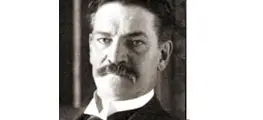
“…on the starboard side, is where this last boat that I speak of was, where the first officer, Murdoch, was at work trying to launch the boat… Then the wave came and struck us …and I grabbed that iron railing and held tight to it, and looked around, and the same wave which saved me engulfed everybody around me. I turned to the right and left and looked. Mr. Smith was not there, and I could not see any of this vast mass of humanity. They had all disappeared.”
Of all the 'alternative' accounts considered so far, Gracie’s testimony is undoubtedly the most interesting. As a historian, he took note of details and events and very soon after the disaster began questioning crew and passengers and compiling his own history of the tragedy that was later transformed into a book entitled The Truth About the Titanic (1913). Sadly, it was published posthumously since his health declined soon after the tragedy and he died in December of 1912, aged 54.
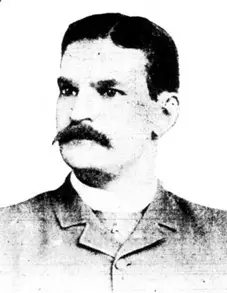
A younger Colonel Archibald Gracie.
In his testimony at the American Inquiry on Day 11, he gives his address as 1527 Sixteenth Street, NW, Washington, D.C. and then proceeds to give a riveting and detailed account, even including a diagram he had drawn (recreated in this document below) (25.) . Refering to his being on the starboard side with Mr. Clinch Smith, he relates:
“Soon after that the water came up on the boat deck. We saw it and heard it. I had not noticed that in the mean time that we were gradually sinking. I was engaged all the time in working, as I say, at those davits, trying to work on the falls to let this boat down. Mr. Smith and myself thought then that there was no more chance for us there, there was so many people at this particular point, so we decided to go toward the stern, still on the starboard side, and as we were going toward the stern, to our surprise and consternation up came from the decks below a mass of humanity, men and women and we had thought that all the women were already loaded into the boats.
The water was right by us and we tried to jump, Mr. Smith and myself did. We were in a sort of cul-de-sac which was formed by the cabin and the bridge, the structure that is right on the boat deck. We were right in this cul-de-sac. I have a diagram here which may explain the position better. The top of the page is the bow [indicating on diagram], and on the right, or on the starboard side, is where this last boat that I speak of was, where the first officer, Murdoch, was at work trying to launch the boat. I would like to point out to you there my position with Mr. Smith… Mr. Smith jumped to reach the deck. I jumped also. We were unsuccessful.
Then the wave came and struck us, the water came and struck us, and then I rose as I would rise in bathing in the surf, and I gave a jump with the water, which took me right on the hurricane deck, and around that was an iron railing, and I grabbed that iron railing and held tight to it, and looked around, and the same wave which saved me engulfed everybody around me. I turned to the right and left and looked. Mr. Smith was not there, and I could not see any of this vast mass of humanity. They had all disappeared. Officer Lightoller tells me that at that same time he was on the bridge deck where I have marked “L” and that the first officer Murdoch, was about 15 feet away, where you see that boat near the davits there. That boat, I understand, was thrown overboard…. there were two; one on the port side and this one on the starboard side…”
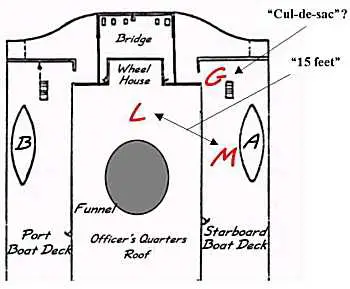
A recreation of the diagram that Gracie made at the United States Inquiry,showing what it possibly looked like, based on his testimony. He marks Lightoller’s position with the letter “L” as being “15 feet” away from Murdoch (M) at one point. He also describes himself (G) being in a “cul-de-sac” in the vicinity of collapsible A, where Murdoch was working. However, according to later evidence, when the wave strikes he has moved further aft along the boat deck.
This excerpt makes several important points from Gracie’s testimony. Firstly, there is no confusion over which side Gracie is on. He is even able to draw a diagram to conclusively show the positions of Murdoch, Lightoller and himself. Two, Gracie states that he saw, on the starboard side, Murdoch “at work trying to launch the boat,” later pinpointing his location as “about 15 feet away, where you see the boat near the davits” (this distance was probably sourced by Gracie from Lightoller’s earlier evidence, in which Lightoller said he was about “fifteen feet” away from collapsible A when he last saw it). He does not see Murdoch commit suicide, but hard at work. Thirdly, as to time-frame, Gracie places his sighting of Murdoch not long before the sea engulfs the forward boat deck, making it certainly one of the last sightings of the First Officer.
Later, in his book The Truth About the Titanic (1913) Gracie described Murdoch’s demise in more detail: “Clinch Smith and I got away from this point just before the water reached it and drowned Chief Officer Wilde and First Officer Murdoch and others who were not successful in effecting a lodgment on the boat as it was swept off the deck.” (43.) As we have seen in his and Lightoller’s testimony, they did not necessarily see this with his own eyes. His statement is more likely a generalisation regarding the men he last saw working on collapsible A. He does not specifically mention exactly what happened to each one but assumes that they would have drowned since they were not seen again.
However, Gracie has this to say about Murdoch in his book:
“Did either the Captain or the First officer shoot himself? Not withstanding all the current rumors and newspaper statements answering this question affirmatively, I have been unable to find any passenger or member of the crew cited as authority for the statement that either Captain Smith or First Officer Murdoch did anything of the sort. On the contrary, so far as relates to Captain Smith, there are several witnesses, including Harold S. Bride, the Junior Marconi operator, who saw him at the last on the bridge of his ship, and later, when sinking and struggling in the water. Neither can I discover any authentic testimony about First Officer Murdoch’s shooting himself. On the contrary, I find fully sufficient evidence that he did not. He was a brave and efficient officer and no sufficient motive for self-destruction can be advanced. He performed his full duty under difficult circumstances, and was entitled to praise and honor. During the last fifteen minutes before the ship sank, I was located at that quarter forward on the boat deck, starboard side, where Murdoch was in command and where the crew under him were engaged in the vain attempt of launching the Engelhard boat. The report of a pistol shot during this interval ringing in my ears within a few feet of me would certainly have attracted my attention, and later, when I moved astern, the distance was not so great as to prevent my hearing it.” (Colonel Archibald Gracie, The Truth About Titanic (43.) )
As for identifying the officers, Gracie seems to be familiar and have no difficulty in recognising Lightoller, Murdoch and Lowe:
Gracie: As to what happened on the other side during our departure, the information I was given by the second officer was that some of
the steerage passengers tried to rush the boat, and he fired off a pistol to make them get out, and they did get out.
Smith: Who fired that pistol?
Gracie: Lightoller. That is what he told me. He is the second officer.
Smith: Are you sure it was not Murdoch?
Gracie: I am sure it was not Murdoch.
Smith: Or Lowe?
Gracie: I am sure it was not. That is what Mr. Lightoller himself told me. I did not hear the pistol. That is what I was told by Lightoller
himself.
This excerpt not only shows Gracie’s confidence in being able to recognise the officers and the fact that Lightoller’s evidence is unreliable since he never went so far as saying that he ever fired his pistol (refer to the Lightoller section), it also has another interesting factor: it is a known fact that at least two officers at some time during the evacuation did fire their revolvers. Fifth Officer Lowe’s use of his gun to ward off would-be interlopers is well reported on and verified from several sources. And although Second Officer Lightoller used his gun and even told Gracie about it, Gracie never heard it, or any of the other instances revolvers were used (there are, in fact, at least six occasions when gun shots, or sounds like them, were reported on, including the forward funnel stays which snapped like the sound of a gun being fired).
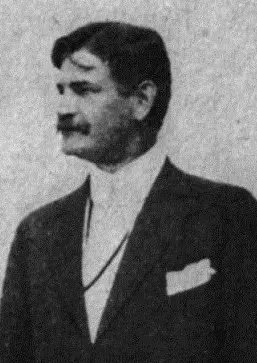
Colonel Archibald Gracie.
Of course, there is a simple explanation to this. It has to be remembered that at this point in the sinking there was almost complete confusion and chaos. The ship was beginning to tilt up at an angle, with furniture inside being dislodged and enormous stress being put on Titanic’s structure, creating numerous noises of metal fatigue that would eventually result in funnels collapsing and the ship breaking in two. And, as pointed out in Gracie’s own testimony, we have a sudden surge in the number of people on deck, with a crowd principally from third class suddenly appearing on deck and heading for the two remaining lifeboats. Most of those who would survive the tragedy were already in lifeboats out at sea. Left aboard there was approximately 1500 people. One can only imagine the frenzied attempts to save themselves and the noise of shouting that would take place.
It is not unlikely then that in such circumstances, some would not observe or hear certain events. And many of those that did in those final moments would never have an opportunity to tell their story. It is an unfortunate fact that the vast majority of information regarding Titanic was forever lost with the 1500 that perished. In Gracie’s case, he was no doubt more concerned about his own survival than on taking note of each event unfolding as the ship entered her final death throes.
But the question should be asked: Since he never reported on how Murdoch died, just that he last saw him working on collapsible A, is it possible that, just as he didn’t hear Lightoller or Lowe use their guns, or the forward funnel stays snapping, that he missed seeing what happened to Murdoch? A key sentence in his The Truth About Titanic account is that he later “moved astern” and asserts that “the distance was not so great as to prevent my hearing it.” But was it too great under the chaotic circumstances?
His book, though an excellent, riveting account, does contain errors. For instance, he was sure the ship went down intact and that those who believed it split in two were fooled by the toppling of the forward funnel. In fact there is a whole section that he uses to debunk the ship splitting "delusion" that procedes directly before his debunkong of the suicide rumours. Also, Gracie “claimed to have witnessed the [Titanic’s orchestra] men set down their instruments a full half-hour before the Titanic foundered” (Illustrated History p.115 (2.)) while the majority of passengers and crew claim the orchestra played right to the end. Interestingly, Gracie does not mention this allegation in his book, although it would be a logical subject to clarify. But he did mention it in “some detail in a talk he gave at the University Club in Washington on November 23, 1912. This was less than two weeks before he died; so it is presumably his last word on the subject.” (Walter Lord, The Night Lives On (21.)). If he truly believed the orchestra did not play right to the end, why did he not state the facts in his authorative book? Hence, it puts an element of a doubt over other events he saw but did not report. There is a possibility then that Gracie missed out on hearing and/or seeing events even though quite obvious to other onlookers. And it must be remembered that he was 54 and although fit for his age, his health was on the decline and he died soon after the disaster. His account is also heavily biased, only mentioning First Class passengers and refering to stowaways or those who jumped into lifeboats as "Latin", "Japanese" or "Italian".
Gracie also admits in his book that "though it was a bright, starlit night, and the ship's electric lights shone almost to the last, it was possible to recognise only one's intimates at close quarters" (Colonel Archibald Gracie, The Truth About Titanic (43.)). So this fact alone brings into doubt his evidence regarding Murdoch. Also, later in his book when Gracie details the numbers and events for each lifeboat, he describes collapsible A as a "boat of mystery" that was abandoned and even discussed the possibility that the collapsible "went down with the ship". If Gracie was nearby and saw exactly what happened this possibility would not have required discussion. Neither would he then have to write that he made "exhaustive research up to date for the purpose of discovering how Boat A left the ship". Clearly he did not see what really happened at collapsible A.
In regard to the alleged shooting and suicide incidents, several of the accounts indicate a large crowd suddenly descending upon a lifeboat causing Murdoch to attempt to regain control and we can thus draw lines of similarity with Gracie’s account of the sudden surge in the crowd. But he makes no reference to any ensuing clashes between officers and passengers. Paul Quinn picks up on this point and writes:
“It is a surprise… to find his [Gracie’s] observations at odds with the majority of other survivors in one key area. Gracie did not mention any disturbances on the starboard side… His accounts are so detailed, it is hard to imagine how he would have forgotten to mention skirmishes and guns being fired, for he places himself on both sides of the deck during these disturbances. Yet his lack of mention of any of these when a number of other survivors spoke of them raises a question concerning his accuracy.” (Paul Quinn, Titanic at Two A.M., p.62 (34.))
Quinn goes on to propose four reasons for this. 1/ That he “was on the move continuously and when the disturbances occurred, he may have always been somewhere else. For instance…When Murdoch later had trouble with passengers rushing collapsible A Gracie may have been over on the port side assisting women getting into collapsible D just before it was lowered. Finally, when the last shots were fired near the starboard side of the bridge just before the plunge, Gracie may have been too far back in the crowd at that point to notice.” 2/ It “may have been an attempt on Gracie’s part to preserve the dignity of the officers. Gracie and Lightoller had spoken at length after the disaster on the rescue ship Carpathia, and it is possible the two may have informally agreed that it would have been best to minimise any incidences of an officer firing his gun… In the case of Murdoch in particular, the two could have concluded that such talk would be a dishonor to the memory of a man who had just lost his life.” 3/ As a survivor of the “most incredible maritime disaster” it was perhaps “too much for him to resist the temptation to embellish his experiences a little –placing himself alongside the crew loading the boats… assisting in getting the collapsibles down from the officers quarters –when he may not have been in all the places he says he was.” And 4/ “that Archibald’s Gracie’s account is absolutely right, and the other witnesses who spoke of skirmishes at the lifeboats were the ones embellishing.” (34.)
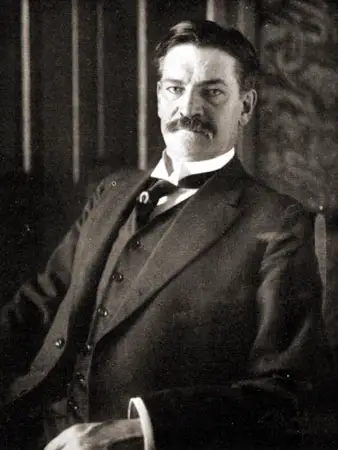
“To find his [Gracie’s] observations at odds with the
majority of other survivors… raises a question
concerning his accuracy.”-Paul Quinn, Titanic historian
Quinn also concedes that anything is possible “including a combination of all the above”. Whatever the case, while he was distracted by his own survival attempts, he may have missed what really happened to the First Officer, basing the fact the Murdoch was in the vicinity on what he had been told by the possibly unreliable Lightoller.
In summary, George Behe writes: “Archibald Gracie never claimed that he saw Murdoch swept into the sea; indeed, the ‘evidence in his book’ makes it very clear that Gracie walked away from Collapsible A shortly before the bridge submerged and the resulting wave surged over the boat deck. Gracie never claimed to have seen what happened to Murdoch after he walked away from Collapsible A.” (George Behe, First Officer Murdoch and the ‘Dalbeattie Defense’ (11.))